Tonight, I'm going to write about one of my favourite things - cuts of meat that are cheap. That's right, baby. We're talking pig's necks and chicken feet. We're going to extract the deliciousness out of these cheap babies and serve up a ramen broth that is mind-blowingly tasty. Rich and salty. Layered and complex. And just so damn yummy.
This ramen broth comes from a book that Santa brought me: Momofuku . The author, David Chang, serves up unconventional Asian fare, making fun substitutions like bacon for for katsuo-bushi (smoked, dried tuna chunks). His book has bold flavours and bold language. And you should get a copy for yourself ASAP. But back to the ramen:
. The author, David Chang, serves up unconventional Asian fare, making fun substitutions like bacon for for katsuo-bushi (smoked, dried tuna chunks). His book has bold flavours and bold language. And you should get a copy for yourself ASAP. But back to the ramen:
2 3x6 inch pieces of konbuLet's make some broth. (Start early, because this one takes about 10 hours).
6 quarts water
2 cups dried shiitakes
4 pounds chicken bits (like feet!)
5 pounds meaty pork bones (like meaty pig necks!)
1 pound smoky bacon
1 bunch scallions
1 medium onion, cut in half
2 large carrots, peeled and chopped
taré to taste (or salt, soy sauce and mirin to taste)
Konbu is available at Asian grocery stores in big sheets. It's basically kelp:

Drop the kelp into a pot with the water, and bring to a boil. Turn off the heat, and let soak for ten minutes to leach out some nice, kelpy goodness.
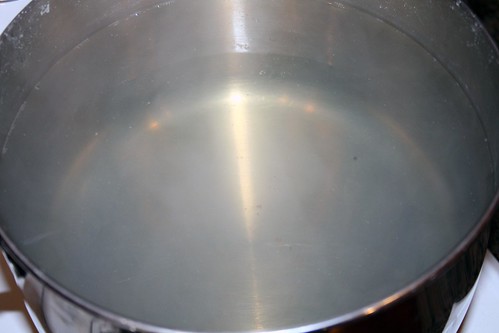
Now remove the kelp, and add the dried shiitakes.
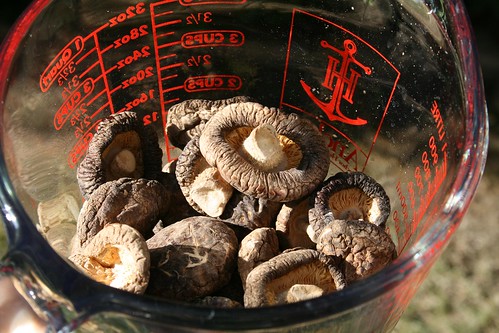
Turn the heat back on and simmer gently for half an hour. They'll change from the pruned up dried shiitakes into these delicious little things:
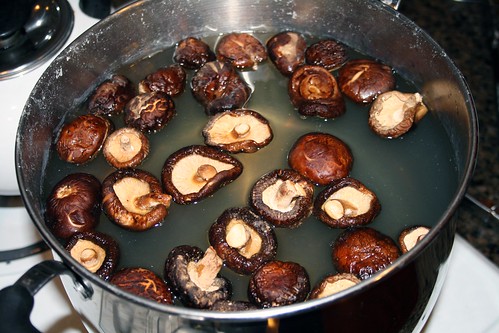
After half an hour, fish them out of the broth (and reserve them for stew or for putting in the finished ramen if you like). The broth will now have an even darker colour to it, and have a nice earthy aroma.

From here on out, the smells are crazy good. I bought 4 lbs of chicken feet for less than $7.00. Perfect cut for stock. And plus: chicken feet! How much fun is that?

Gently lower the chicken feet into the screaming hot broth. Simmer the chicken feet for an hour, until the meat loosens from the feet and you've added all kinds of chickeny, footy goodness to the broth.
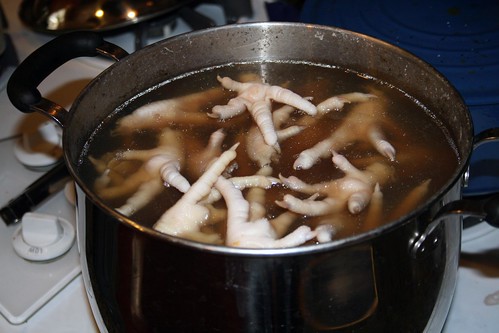
The chicken feet will puff up a bit.
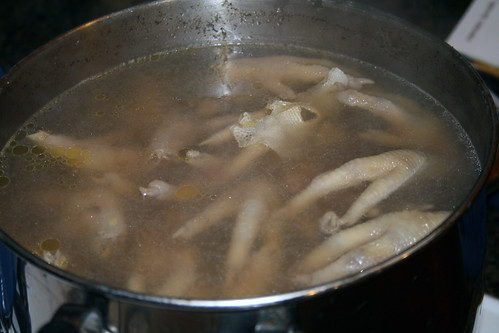
While those chicken feet are gently simmering, you can brown the pork.

Pre-heat the oven to 400°F. Pat down the meat to dry, then place it on a cookie sheet. Brown for an hour or so, flipping it once around half way through. It should look and smell delicious (I often use smell as a way to remind me to check the oven - if you can smell it, it's probably well on its way).

After the chicken has been gently simmering for an hour, pull the chicken out of the broth. Place the browned pork in the pot and the bacon, and continue to simmer, for one hour. Remove the bacon and discard. Skim periodically, and keep enough water in the pot to cover the pork. Simmer, simmer, simmer, for 5 to 6 hours, while it makes your home smell like pork soup, YUM! In the last hour, add the vegetables.
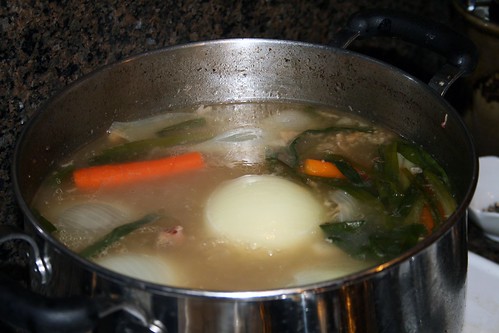
Simmer for one more hour with the vegetables, then pour the broth through a fine sieve. Season with taré to taste. (I used a lot, and made the broth nice and salty). From David Chang's book:
"Taste it and get it right. I like it so it's not quite too salty but almost. Very seasoned. Under-seasoned broth is a crime."Yeah, baby! We then briefly boiled some fresh ramen noodles from our local Asian market, and served the ramen broth in a bowl with the noodles, some leftover smoked turkey and a little bit of cilantro garnish.
This broth is soooo good. It's rich and salty and has multiple layers to it. And it keeps pretty well in the fridge (I've had this soup 3 times this week). Next time I make it, we're going to make a *much* larger batch, and freeze it.
If everything else in this book is even half as good as the ramen broth, Momofuku is going to bring me a lot of pleasure in 2010. Yum.
is going to bring me a lot of pleasure in 2010. Yum.

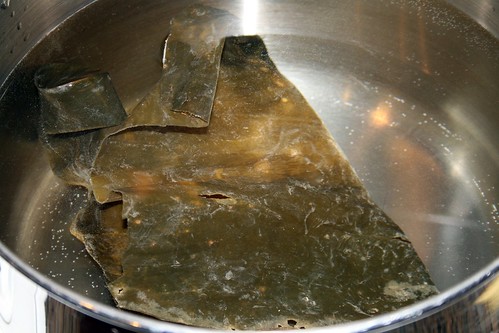
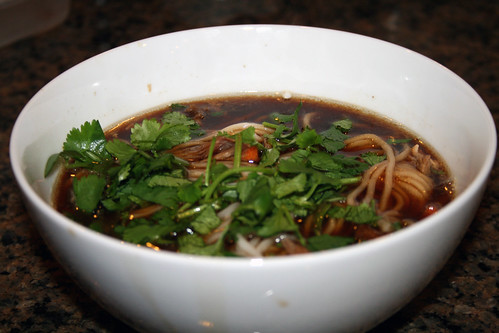
5 comments:
I just got Momofuku as well, and the ramen is definitely on my hit list (although there are a ton of dishes in the book that I want to make). Your rendition looks really good!
Yeah, we've made a few things from Momofuku, and they've all been really, really good. I'm looking forward to playing with this book this year.
Let's not forget that we tried to make noodles as described in Momofuku, but unfortunately, without a pasta machine, proved so physically tiring it wasn't worth the $2 in savings from buying commercially made noodles.
Hi,
I have a quick question- we are going to make this on an upcoming weekend- we've got the kombu, feet and necks, just need the time.
I'm curious that most recipes call for miso- how would that change things, in your opinion, or are those just "shortcut" recipes?
Miso ramen will have a slightly different flavour. It's just another source of that delicious umami flavour. That said, I had a miso ramen recently (at Yakyudori Ramen in San Diego), and I didn't like it as much as their other ramens. Individual taste, I think.
The only ramen recipe I can highly endorse is this one, because it's the only one I've ever tried to make. Hope that helps!
Post a Comment